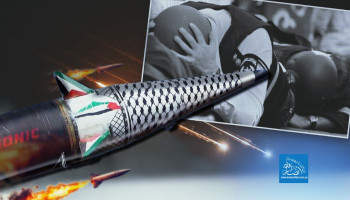Friday night will not be forgotten in the memory of the Israeli entity. A sound from the far south, from the mountains of Sana’a, pierced the skies at supersonic speed, splitting in the atmosphere into cluster warheads that disrupted calculations and humiliated defense systems upon which the Zionists had spent billions of dollars.
Five interception systems—“THAAD,” “Arrow,” “David’s Sling,” and the “Iron Dome”—launched their missiles in a desperate attempt to stop it. Still, they stood powerless before Yemeni ingenuity that reshaped the equation with new engineering intelligence.
“Supersonic,” “cluster,” “fragmentation”—these are military labels too pale to capture the truth: the Israeli entity saw its reflection in the mirror of defeat once again.
That night, sirens wailed in Tel Aviv, Yaffa, and Askelan. More than 200 settlements were on alert as settlers rushed into shelters, while fragments of the “Palestine 2” missile landed near Lod Airport, “Ben Gurion.” The Zionist enemy's defense systems became nothing more than faint echoes of a Yemeni missile that defied laws and broke through barriers, splitting into multiple warheads as if reproducing rage into new bodies, declaring: no dome above you can shield you from the will of the people.
Yemen’s Statement and Evidence of Failure
In a military statement, Yemeni Armed Forces spokesperson Brigadier General Yahya Saree confirmed the operation was carried out with a “Palestine 2” hypersonic missile. This missile was not just a ballistic projectile but a strategic message: Israeli defense systems are no longer invincible. Yemeni deterrence now possesses tools beyond what “Israel” has known from its traditional adversaries.
Footage showed the missile splitting midair and several Zionist interceptor missiles failing. Other recordings captured direct hits inside Tel Aviv.
Earlier, skies over the “Gaza envelope” witnessed a Yemeni drone operation that penetrated the airspace of occupied Askelan and Yaffa, striking its targets successfully. Despite the Zionists launching interceptor missiles and sending intensive jet and helicopter patrols, attempts to stop the drone failed. The accumulation of operations in a single night—missiles and drones alike—revealed a deep flaw in the Israeli entity’s defense doctrine.
The Dilemma of Failed Interceptions
Inside command centers in Tel Aviv, confusion reigned as committees scrambled to uncover the reasons behind the “disastrous failure.” Was the missile a splitter? Clustered? Did it fragment into ten warheads? All possibilities remained open, but one certainty emerged: Sana’a can now shatter the wall of illusion. Enemy generals admitted: “The Yemenis are capable of producing their own missiles.” And the bitter question haunted them: if this was only the first strike, what would the next one look like?
The following day, Zionist media reflected the anxiety. Yedioth Ahronoth admitted: “The army is investigating the cause of the interception failure.” The army’s radio station acknowledged the missile may have fragmented into several warheads midair. "i24 News" reported that cluster munitions pose an unprecedented challenge to "Israeli" defense systems. Channel 12 confirmed police dealt with several sites containing missile fragments across Tel Aviv. Shrapnel fell into a yard in the Modi’in area, with ongoing inspections suggesting the Yemeni missile carried three warheads.
In central Tel Aviv, fear dominated as fragments landed near Ben Gurion Airport, disrupting air traffic and forcing millions into shelters. The Zionist entity was not facing just a missile but a confrontation with innovative military engineering that changed the balance of the conflict.
Admissions of Defeat
From inside Tel Aviv’s leadership halls came admissions of failure. An initial Israeli army investigation revealed that the Yemeni missile fired Friday toward Lod Airport carried a fragmentation warhead. Zionist radio “Kan” noted it was the first time the Houthis had used such a missile against "Israel".
The Zionist outlet "Walla" cited air force sources saying Yemenis used—for the first time—a warhead capable of splitting into three before impact. Analysis suggested the ballistic missile carried cluster munitions, complicating interception.
Those sources confirmed Yemen’s local capacity to develop and manufacture missiles, with investigations ongoing. They estimated the missile carried ten small munitions loaded with explosives, noting that the interception strategy in this case is under review.
"Walla" stressed that if the final investigation proves the missile was indeed a splitter, "Israel" will be forced to reconsider its interception policies.
Meanwhile, "Maariv" revealed that the Zionist entity resorted to using its Iron Dome system—designed for short-range projectiles—against falling fragments, confirming the failure of advanced systems like Arrow, THAAD, and David’s Sling to counter longer-range threats.
"i24 News" reiterated the same conclusion: all Zionist systems failed to intercept the Yemeni missile. The channel noted that falling fragments near Ben Gurion Airport underscored the unprecedented challenge posed by cluster munitions, which disperse explosives over wide areas.
Zionist Navy Commander Maj. Gen. Eliezer Marom told FM 103 Radio: “We must remember Yemenis can produce missiles. I believe the ultimate result should be moving southern forces in Aden militarily against Sana’a. The government in Aden cannot face Sana’a alone, and our efforts are limited. We must make joint efforts to strike Sana’a while supporting the south.”
On Sunday, Yedioth Ahronoth confirmed that three interception attempts against the Yemeni missile failed. It described the strike as surprising since it was the first of its kind, warning that Israel’s counterattacks would not necessarily stop Yemen from continuing its missile launches.
International Coverage and Concerns
The "Associated Press" quoted a Zionist air force official saying the Yemeni missile represents a new threat, designed to split into multiple warheads, making interception harder.
The "Jerusalem Post" echoed concern, stating Yemen’s use of ballistic splitter missiles against "Israel" marks a dangerous new escalation. The paper noted that such weapons significantly expand the threat range, complicating interception and reducing the effectiveness of traditional systems like Arrow and David’s Sling.
"The Post" reported that Sunday’s air force investigation confirmed the Yemeni missile carried cluster munitions—the first time "Houthis" deployed such weaponry in the war. The failure of the Israeli entity’s multi-layered defense raised serious questions about its limitations.

Powerlessness Masked by Bombing
And as always, the powerless resorted to bombing the weak. Israeli warplanes struck power stations and fuel depots in Sana’a. Yet Sana’a, which has endured a decade of siege, knows that for every station destroyed, a thousand are born in the hearts of its men. Every raid that falls gives birth to a new missile—more determined, longer-ranged, and closer to Tel Aviv.







